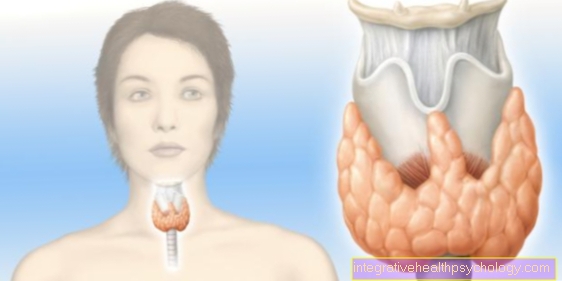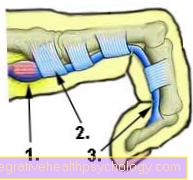The rubber dam
What is the rubber dam?
The rubber dam includes a square rubber sheet that shields one or more teeth from the oral cavity. This gum does not let fluids or saliva pass through. It also protects the patient from swallowing or breathing in foreign bodies. Through small holes or recesses in the rubber, the teeth can protrude from the rubber up to the gums. The rubber is held in place by clamps that clamp on the tooth and by a rubber dam frame that tightens the rubber on three sides. In addition, small wooden wedges, dental floss or small rubbers can be used to fix the rubber dam even closer to the tooth. The elastic is made of latex. But there are also latex-free rubbers for allergy sufferers.
You might also be interested in: Professional tooth cleaning

Indications
The general function of the rubber dam is to shield one or more teeth from the moist oral cavity and to keep the area in which one works as dry as possible.
A rubber dam is indicated when working with plastic, as plastic does not tolerate moisture. When placing a plastic filling, no liquid or saliva should get into the hole, otherwise the plastic will not stick to the tooth. In addition, there are bacteria in the saliva that would be trapped under the filling and could lead to tooth decay.
You can find more information under: Tooth filling with plastic
If a ceramic crown with adhesive plastics is used, a rubber dam is also helpful because the entire tooth must be dry for this work.
A rubber dam is also often applied during root canal treatment. The point behind this is that as far as possible no germs from saliva or gum fluid get into the root canal. The aim of root canal treatment is to get the canal free of bacteria. With a root canal treatment there is an additional problem that the canal is rinsed with aggressive substances that are harmful to the oral mucosa and taste unpleasant. During this treatment, there is also a risk that a root canal file can be swallowed or inhaled. A rubber band would catch the instruments.
Additional information on the topic Root canal treatment you'll find here.
When working with plastic, high-percentage alcohol is used for disinfection, which should not necessarily get on the oral mucosa.
However, a rubber dam cannot be placed for every tooth or treatment. If the defect on the tooth goes under the gums, a rubber dam cannot dry-shield this area. It is also the case when the preparation margin of a filling is below the level of the gums. Sometimes the tooth is shaped in such a way that the rubber dam clamp does not hold on to the tooth and the rubber dam is not tight. In these cases it is annoying to put on a rubber band.
Amalgam removal
Amalgam fillings that contain mercury contain toxins that should not be swallowed. If a filling is to be removed, it is advisable to put on a rubber dam. Because when drilling out the filling material, amalgam dust is created, which combines with the drilling water. This water has to be sucked off, otherwise it will flow into the throat and the amalgam dissolved in water could be swallowed. The amount of mercury is very small and not directly harmful, but it is also not very good for the body, so you can at least try to ingest as little of it as possible.
Some fillings are very brittle, so the fillings break into large pieces that can be vacuumed directly. If it is very firm and still intact, it creates more dust that can get into the throat.
In many practices, a rubber dam is not used to remove amalgam, as the assistants are usually very practiced to suction off the amalgam residues immediately. In addition, amalgam fillings are often very deep, so that the rubber dam does not close close to the tooth. In this case, a rubber dam is actually bad, as more water with amalgam can pass through the gap between the tension rubber and the tooth.
It is important that amalgam is a material that lasts for a very long time, that is, the fillings that are removed are usually old. In the long run, a lot of mercury has already loosened from the filling, so that there is no longer much mercury in the filling. If you swallowed a little of the amalgam dust, it would not be more harmful to the body than a filling that repeatedly emits mercury vapor over several years.
For more information, see:
- Tooth filling with amalgam
- Mercury poisoning
execution
preparation
The rubber dam does not require much preparation. Most of the time, the helper puts on the elastic. A tooth cleaning may have been done beforehand, as the brackets do not hold well on the tooth if there is still tartar there. In addition, the teeth should be clean before performing major interventions such as a filling or a root canal treatment. The preparatory work of the assistant consists in choosing a suitable bracket depending on the size and type of tooth. It is tried on beforehand without a rubber band on the tooth to see whether it holds well and is tight against the tooth.In addition, depending on the treatment, one or more holes are punched in the rubber beforehand, which allow the teeth in question to protrude from the rubber.
How is it created?
There are different ways in which the rubber dam is applied. What they all have in common, however, is that the elastic band is placed over the teeth and held in place by the rubber dam clamps. Rubber bands and dental floss are then placed around the teeth to hold the rubber in place. Depending on the treatment, wooden wedges are added that bend the teeth a little apart. The number of holes that are punched in the rubber depends on how many teeth need to be treated.
With a root canal treatment, the bracket is placed around the tooth in question. In the case of anterior fillings, the neighboring teeth also come out of the rubber in order to better match the shape and color of the filling. In the case of ceramic crowns, it is also important to expose the immediate neighboring teeth in order to ensure the contact between the crown and the neighboring teeth.
You might also be interested in:
- Root canal treatment
- Dental crown
- Tooth filling
Brackets
There are also different brackets for different teeth. Brackets for front teeth, for the small and for the large posterior teeth are roughly divided. The choice of different types of brackets is important, as the small molars have a smaller circumference than the large molars.
Within a group there are again different shapes, since the shape of a tooth varies from patient to patient. This gives the dentist the opportunity to try out which bracket best fits the respective tooth. All clamps have two small wings that prevent the rubber dam from slipping off the tooth again.
For the general structure of the teeth, read also: tooth
How uncomfortable is that?
The clamps are uncomfortable, but you can't speak of pain. The feeling corresponds to pressure exerted on the tooth and gums. But you get used to this feeling over time. The detachment of the clamp becomes uncomfortable again. The uncomfortable feeling varies depending on the tooth. If the tooth is already suffering from pain, due to inflammation of the nerve or for other reasons, the brace is more uncomfortable. In such cases, the bracket can also be applied to another tooth
Also read: Dental pain radiation
Risks and Side Effects
Since the brackets are close to the gums and even partially clamp off the gums, the gums can be easily injured. The brackets do not hold well on teeth that are not very stable in the bone. If the rubber is too tensioned, it pulls the tooth indirectly via the bracket. If the selected bracket does not fit exactly around the tooth, a bracket that is too tight could damage the tooth structure.
If there is a filling in the area of the tooth neck, it could be blown off by the pressure of the clamp. A problem exists with patients who have difficulty breathing through their nose. The treatment causes saliva to collect in the oral cavity, which can be swallowed. Mouth breathing should still be avoided during the session.
Duration
The length of time the rubber dam is in place varies depending on the treatment.
In the case of fillings, it is only created when the filling is placed.
The rubber dam interferes with removing caries.
With a root canal treatment, the rubber dam is sometimes placed at the beginning of the treatment. If the root canal has already been opened, it is best to place the rubber dam at the beginning. Caries may still have to be removed when opening for the first time. The rubber dam is only applied when a filling has to take place, or even for the actual root canal treatment. The investment itself is quick, provided you have a certain amount of practice. It's gone even faster. However, the application works differently depending on the patient. If two or more clamps are used, it will of course take a little longer. Most of the time, the dentist and assistant are so experienced that this can be done within a minute.
costs
For the creation of a rubber dam, there is no billing item in the assessment standard for dental services (BEMA). However, there is the possibility of the billing item "special measures for fillings".
Even those with statutory health insurance who make use of private treatment have to pay for the rubber dam privately if this is necessary for the treatment. Some dentists require the rubber dam for certain treatments. The costs for the application are already included in the price for the entire treatment. That is why the prices differ slightly from doctor to doctor.
Alternatives to the rubber dam
The alternative to keeping the work area dry is that the saliva and fluids are sucked away. In addition, cotton rolls must be placed in the lip and under the tongue.
A MiniDam is ideal for filling therapy or inserting a ceramic restoration. These are small silicone clips that are attached to a rubber. You can put the MiniDam over the teeth that are being treated. The advantage of these small rubbers is that they are more comfortable for the patient. But the practitioner can also work more calmly, as saliva is kept away from the work area.
A cheek retractor helps to reduce the fluid in the mouth. This is a one time rubber dam that holds the cheeks and lips away. The tongue can still moisten the teeth. Protection against swallowing or breathing in small instruments is only possible with a rubber dam.





























